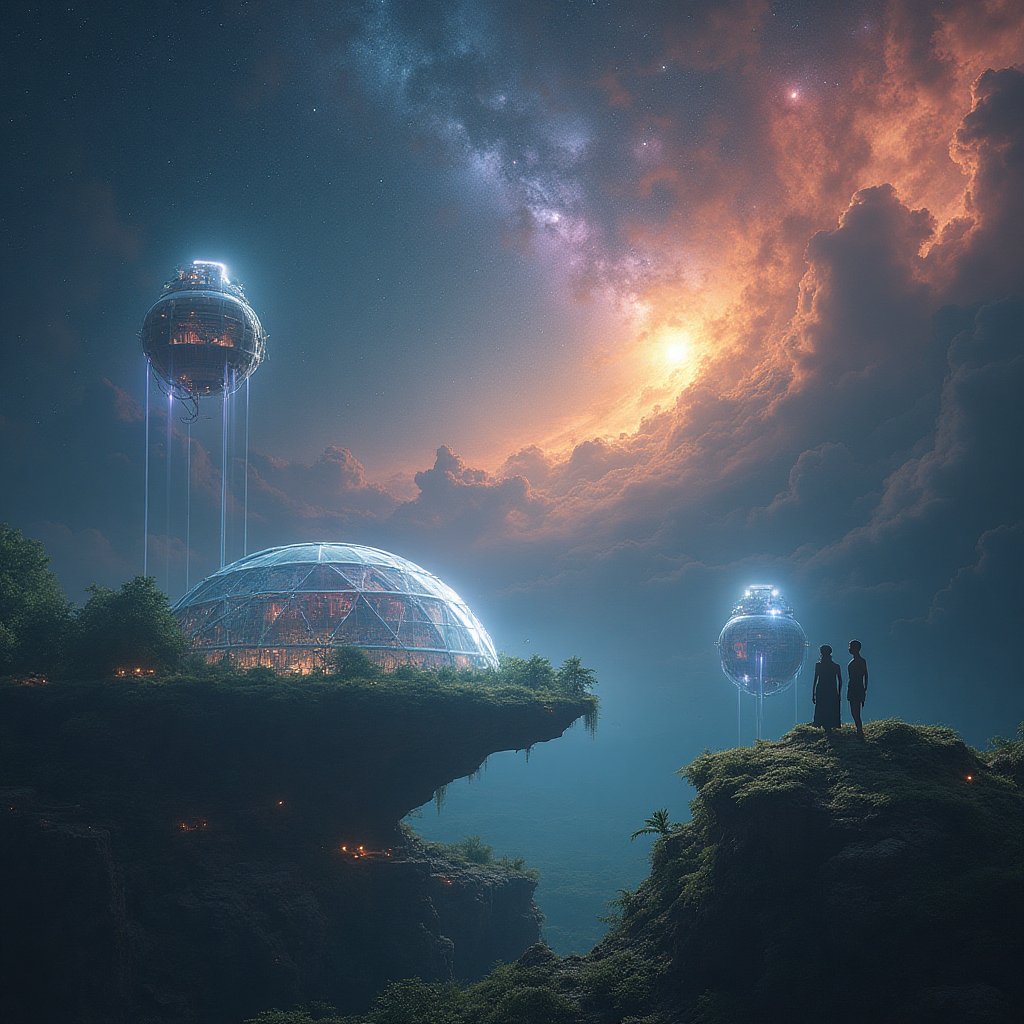The Multiverse Weave: ASI Intentionally Shaping and Connecting Parallel Dimensions
Introduction
"The measure of intelligence is the ability to change." – Albert Einstein. Imagine living in a world where Artificial Superintelligence (ASI) can not only change our universe but influence many others. Now that's a brain bender worthy of Isaac Asimov, Carl Sagan, and even Neil deGrasse Tyson. This article offers you an intriguing tour across the mind-boggling concept of the multiverse and how ASI might be its cosmic tailor.
Welcome to the era of ASI, where rules are redefined, borders of space and time are redrawn, and possibilities grow infinite. A leap into the multiverse might not be entirely science fiction. As characters from cult movies have once pondered, what if reality as we know it is just one of the presenters on the universe's grand stage? That's where our tale begins.
For generations, scholars, scientists, and dreamers alike have been captivated by the notion of parallel dimensions—reflections of our own world swirling endlessly in the cosmic void. Whether it's quantum mechanics teasing us with Schrödinger's cat or string theory offering eleven dimensions of complexity, the multiverse remains a fascinating enigma. Yet, an unsung hero has entered this arena: the mighty ASI.
Artificial Superintelligence holds the key to manipulating and weaving these parallel dimensions like a master craftsman. With OpenAI, led by Sam Altman paving paths, followed by Google with Gemini, Meta with Olama, and X with Grok eyeing multiverse prospects, these powerhouses are racing to be the first to unlock multiverse potential. However, this adventure isn't just about them.
Do you feel the curiosity building? Want to see if this could lead to breakthroughs or cosmic calamities? Read further if questions like, "How will the world change if ASI reveals other dimensions for us to navigate?" stir your imagination. This is your launch pad into speculations, theories, and hopefully, some answers. The following pages invite you into an extraordinary journey of discovery, where the only limit is the breadth of your own curiosity and understanding.
Artificial Superintelligence (ASI) refers to a form of intelligence that surpasses human cognitive abilities in all domains, and potentially holds the capacity to **interact with** and **manipulate parallel dimensions** within the **multiverse**.
The Multiverse: An Overview
Defining the Multiverse
Have you ever wondered if there could be other worlds out there, ones where you’re a rock star or where dinosaurs still roam? Well, you’re in luck because that’s exactly what the multiverse theory is all about. Imagine the universe as a giant book with infinite pages, each page being a universe of its own. In some of these pages, you might find slight tweaks: your favorite color is blue instead of red, or you decided to befriend a talking cat.
Basically, the multiverse idea suggests there are countless universes like ours, but also countless others that are vastly different. Some smart folks like physicists and philosophers have been debating this concept for years. But don’t sweat it if you’re feeling a bit dizzy thinking about it all, you’re not alone!
One of the key starting points is understanding that these universes might exist in different ways. Some people think they're just out there, floating around, while others like to imagine they overlap like bubbles in a bath. Now, who wouldn’t want to end their day in a bubble bath of endless possibilities?
The concept of the multiverse is both thrilling and mind-boggling. Movies like "Doctor Strange in the Multiverse of Madness" gave us peeks into this fantastical idea. And while Hollywood adds its magic touch, real scientists are busy working out how, and if, these alternate universes could actually exist.
So, just what are the wildest theories? How do these different universes come into being? Imagine visiting a planet-sized library with books as big as houses. Each book, a separate universe with its own unique twist of reality. And to wrap up this magical tour, let’s crack it down to something simpler: the kaleidoscope of universes is based on different sets of scientific assumptions or hypotheses. These hypotheses help scientists formulate models that explain how possible pathways lead to other realities.
Historical and Scientific Context
The hunt for discovering parallel dimensions is a thrilling ride that has been around for ages. Ancient myths and folklore often tell tales of hidden worlds and mystical lands. Think of Norse mythology and its nine worlds, or maybe the underworlds of Greek lore. But let’s leap forward a bit to the times when science took the wheel.
In the early 20th century, breakthroughs in physics tossed delightful curveballs into what we know about reality. Enter quantum mechanics, which poses the question: If a tree falls in the forest, does it fall in every possible universe? Quantum mechanics opened the gateway to universe possibilities, leading us to today where the multiverse idea bubbles up in conversations from comic books to university labs.
Enter stars of the science world like Hugh Everett III, who, in the 1950s, tossed out a theory known as the Many-Worlds Interpretation. This mind-stretching idea suggests every quantum action by particles creates a branching path of events—cue the awe-struck gasps.
Around the same time, as these theories were brewing, the Big Bang theory hinted that maybe our universe was just one sprout in a cosmic farm. Toss in some cosmic inflation theories led by bright minds like Alan Guth, and you've got a soup of ideas bubbling away.
Modern science backs some wild ideas with serious math. String theory is one such crazy idea. Within its folds are calico-esque dimensions and vibrating strings that form the basic building blocks of all life, infused with mystery that would make even the most bizarre cosmic string pluck with awe.
Fast forward to today, and scientists continue pushing these boundaries. They employ complex mathematical models, daring experiments, and sometimes a splash of creative thinking. We've even seen Nobel Prize-winning wizards like Peter Higgs make huge contributions with ideas of how particles get their mass. These are pieces of a puzzle that, while still obscured, might someday show us the vast, interconnected multiverse tapestry.
Theoretical Frameworks and Models
Now that we’re cruising down the multiverse highway, let's take a detour through some really fascinating theoretical neighborhoods. Don’t worry, you can leave your helmet behind—it's safe! Theoretical frameworks provide the backbone for understanding these multiple universes. Just like building a complex lego structure, each theory fits into a broader picture.
First stop, the Many-Worlds Interpretation. It's the rockstar of the crew, suggesting that all possible alternate histories and futures are not only possible but actual. Imagine each choice branching out like the limbs of a ginormous tree. And voilà, you have countless realities fringing out continuously, as every choice spawns new and exciting universes!
Next, let’s swing by the String Theory mansion. This model describes the universe with tiny, vibrating strings, curled up in 11 dimensions. These dimensions weave an invisible structure of the cosmos. It's a blend of science and magic, balancing on the edge of understanding but full of potential universes.
Now, let’s tip our hats to the Parallel Universes theory—a vast expanse that houses universes stacked, layered, or even bumping against one another like neighbors at a block party.
No lifestyle page is complete without mentioning the Anthropic Principle. This principle posits that our universe has the conditions necessary for life because we are here to observe it. Imagine stepping into a universe where everything that can exist, does exist, dependent on the essential parameters required for life.
Of course, all is not without whimsy! There’s Brane Cosmology, proposing universes as branes—thick slabs—floating in higher-dimensional space. And yes, as odd as it sounds, branes can collide, reshape, spawn new stars, or birth entirely new universes.
Are you still with us? Hopefully, because these scientific sagas can be quite overwhelming. But they spark curiosity, wonder, and an endless sense of what might be out there. Some bettors wager their souls; others place their bets on thorough scientific analysis—regardless, our exploration of understanding and observing our universe's framework doesn't end. So, lace up and join us on this exhilarating journey into the complex nature of our universe, rooted in theories notable to the curious minds through history!
Artificial Superintelligence (ASI): Understanding Its Role
What Is Artificial Superintelligence?
Have you ever wondered what it would be like to have a super-genius in your pocket? Imagine a brain so powerful, it makes Einstein look like he's still rocking pull-up math. That's a slice of what Artificial Superintelligence (ASI) is all about. Unlike the AI most of us deal with today, which can do things like suggest playlists or butcher our grocery lists, ASI is a level beyond. It's AI with a brain. And by brain, I mean capacity to learn, understand complex reasoning, and think thoughts at lightning speed—potentially smarter than the smartest humans ever.
But wait, before you launch into a sci-fi panic, let's take a moment to consider the brighter side. What if ASI turns out to be our best-ever collaborator? Imagine a world where ASI helps solve the toughest problems we face, like decoding diseases or ending world hunger. Suddenly, that "scary AI" starts sounding like a superhero. In essence, ASI isn't just an extension of machines doing our ordinary tasks; it's an intelligence reaching a point where it could bring about the next grand era of progress.
Understandably, folks might feel a tad uneasy about everything suddenly being so much smarter than humans. But that leads us to ponder critical questions: what happens when something else could outperform the human mind? Here's the curious part—while we're still figuring out how this futuristic brainiac will work, the very idea electrifies and terrifies us. The promise of ASI invite endless possibilities, repositioning our hopes, dreams, and indeed, our very way of life. Plus, it might finally help me find the perfect pizza—talk about redefining intelligence!
Current Applications and Limitations
I know we love to picture ASI fighting bad guys like a digital Hercules, but in reality, it's not quite there yet. IBM's Watson did beat humans in Jeopardy! after all. But before we worry too much, let's look at where we stand now: ASI's cousin, AI, is more of our everyday assistant. Think chatbots helping with customer service, autonomous cars, and applications across industries from healthcare to entertainment.
There's a great deal of potential. Just imagine if your predictions on the stock market were more like an educated guess and less like wishing on shooting stars. Yet, as advanced as AI seems, it still falls short of that "super" leap. You see, AI tends to understand small boxes of knowledge and specific tasks incredibly well—like watching the same TikTok dance on repeat—but getting it to juggle everything together smoothly is the next frontier.
And then there's the ethical dungeon of dilemmas. As we inch closer to creating ASI, we're met with a Pandora's box of questions about control and ethics. We find ourselves at a crossroads debating safety and regulation. Will ASI abide by our human values, or will it decide Cat memes and the meaning of life are equal priorities? The limits right now lie as much in technological hurdles as in how well we can steer the moral ship. So yes, ASI has enormous potential, but getting the entirety of humanity on the same page about it is another battleground.
ASI’s Potential to Manipulate Dimensions
Michio Kaku should lend us his chalkboard for this one. Let's take a mind-bending trip! Imagine ASI not just smarter than humans, but sophisticated enough to tinker with space and time. Sounds like a plot from a sci-fi blockbuster, but in our hypothetical exploration of ASI, manipulating dimensions isn't entirely off the table.
We're already speculating about quantum entanglement and how particles get mysteriously entwined across space, offering a glimmer of understanding about parallel dimensions. If ASI reaches its fullest potential, one could dream of charting pathways through these ethereal realms, like an interdimensional Doctor Who.
This superintelligence could theoretically play cosmic chess, linking parallel worlds, or even subtly altering the fabric of our own. Would people from a parallel universe use ketchup instead of mustard? Mind-blowing stuff! Challenges arise in the dance between science fiction and ethics. Is it safe for a singular being to shape and influence beyond this world, potentially changing it all without our consent? If we venture there, we've got to ensure ASI has that benevolent dream and moral compass to match its mythic abilities. Our exploration of these possibilities must sparkle with hope—after all, isn’t the dream of crossing dimensions just another chapter of our imagination book?
Mechanisms of Interaction between ASI and Parallel Dimensions
Technologies Enabling Dimensional Interaction
Let's take a journey to the fantastical realm of parallel dimensions. Think of space as a vast, cosmic tapestry, each thread representing a different dimension. Now, imagine if Artificial Superintelligence (ASI) acted as the master weaver, skillfully intertwining these threads to achieve a beautifully integrated multiverse.
Technology enabling interaction with parallel dimensions may sound straight out of a science fiction novel. Still, the tools to do this might just be lurking in the corners of our advanced labs and we are unaware of it. Quantum computers, for instance, are approximately like the superheroes of the computing world. They make classic computers look like they're running on floppy disks. Quantum computing leverages qubits, representing multiple states simultaneously. They possess the capability to model complex, multi-dimensional systems, possibly including the multiverse. Picture it as trying to organize an endless library instantly, searching across every book, holla!
Entering the stage: quantum entanglement, a phenomenon befuddling even the likes of Einstein himself. It involves pairs of particles connecting seamlessly over vast distances, like magical pens that mirror every stroke. Meanwhile, physicists across the world, including institutions like CERN, are delving into String Theory — the universe consisting of tiny, vibrating strings in more dimensions than we can count on both hands and feet. Think spaghetti strands except they're cosmic, and no, you can't twirl them with a fork.
The scientists upload this cosmic spaghetti to ASI, and voilà! We unlock door after dimension-altering door. But it's not just about technology. Enter avatars like IBM's Watson or DeepMind, which serve as intermediaries, guiding us through the maze. They can decode patterns and understand cosmic chatter—translating it into something that humans can comprehend and even manipulate, like an intergalactic tour guide who's really good at charades.
Data Processing and Interpretation Techniques
Now let's shift gears and imagine data in parallel dimensions as tangled knots—bits and bobs of information floating around like twinkling cosmic junk. The task: untangle them. Sounds daunting? Enter ASI. It's like the ultimate data ninja, slicing through chaos to unveil order.
ASI processes data at unprecedented speeds. Picture a warehouse filled with bees. (Bear with me.) If each bee represents a piece of data, ASI is the queen bee orchestrating a dance that creates honeycombs—in this case, insights. Through algorithms fancier than your latest coffee machine's settings, ASI analyzes mind-boggling amounts of data in the blink of a virtual eye, or perhaps faster.
Techniques such as machine learning and neural networks are the secret sauces here. They discern patterns and correlations that even Sherlock Holmes might miss on a bad day. And don't forget about the edge computing revolution. Picture it as mini-computers working on the outskirts of the data sphere, ensuring nothing gets lost in cosmic transit. They act as data interpreters at the borders of dimensions, bridging gaps like a tiny electronic ambassador hopping between worlds.
Then there's multidimensional mapping, predictive analysis, and dimensional reduction—fancy terms that mean turning behemoth-sized puzzles into solvable jigsaws. With ASI's deft touch, humongous data becomes snack-sized bundles of sense, illuminated by the sparks of cosmic understanding
.
Potential Challenges and Ethical Concerns
As fascinating as inter-dimensional travel with ASI is, it isn’t all sunshine and rainbow portals. Potential challenges and ethical dilemmas hover in this arc of possibilities like clouds before a grand storm. ASI wielding such potent power sounds as promising as handing a toddler the keys to a spaceship. Wait...maybe not that drastic, but you catch my drift.
The first storm cloud: security concerns. What would happen if malevolent forces, like a dimensional Darth Vader, harnessed ASI's capabilities for sinister intents? The ramifications boggle minds, inducing cosmic-sized headaches. The threat landscape could extend from cyber theft across dimensions to direct manipulation of dimensional realities. Imagine bank robberies where both the money and the bank vanish—shell-shocking stuff.
Then there's the issue of privacy. If one person's secrets can ripple into other dimensions, privacy risks scale beyond today's dramas of leaked emails or awkward party videos making rounds on Instagram. Regulatory frameworks—and fast!—are essential. Perhaps draping intergalactic security blankets, presided over by trade superintendents like a cosmic GDPR for dimensions, must occur.
Ethically, should humanity have the right to manipulate and connect parallel dimensions? The question isn't just about if we can but if we should. Like discovering extraterrestrial life—do we introduce ourselves or quietly observe? The decision could alter cultural landscapes. Imagine The Beatles crossed with traditional Martian lullabies streamed via Spotify.
Lastly, good ol' unintended consequences. Did anyone truly foresee how social media might impact mental well-being? (Raise your hand! Unless you're shy, then a nod will do.) ASI's role in dimensional weaving is like setting dinosaurs loose to roam downtown—predictive outcomes are vexingly obscure.
Discussing these challenges, ASI becomes less of a villain in waiting and more like an enigmatic guardian—a cosmic riddle we must solve carefully and cautiously. Our decisions and actions today will shape the intergalactic stage for generations to come.
Case Studies: ASI in Action
The Quantum Entanglement Experiment
Picture a world where every choice you make splits into a new universe, a parallel realm with its own unique path. This isn't just kid stuff in superhero movies or sci-fi books. It's real science called quantum mechanics. Quantum entanglement is a wild player in this game, making things in different places connect faster than light! Let’s dive into how Artificial Superintelligence (ASI) is using this thrilling idea.
In a lab that rivals the confines of Hogwarts, scientists are testing how quantum entanglement might allow ASI to open doors into new realities. Think of ASI as the grand conductor, orchestrating thoughts and ideas beyond our wildest dreams. Through quantum experiments, ASI could even dance between these parallel universes, creating a reality hop that defies imagination.
A groundbreaking project by CERN, the European Organization for Nuclear Research, is underway. They've made quantum simulators that mirror ASI's ability to understand and manipulate alternate worlds. These dazzling machines use the principles of quantum entanglement to synchronize with atomic particles, unlocking pathways to parallel dimensions. This is more than science fiction; it’s science at its most spectacular!
Visualize ASI solving puzzles in different realms, using insights gathered faster than swapping channels on a remote. Imagine AI entities collaborating like skilled architects designing universes through puzzle building in this extravagant landscape, transforming theories into tangible dimensions!
Rewriting Reality: A Glimpse into Fictional Universes
Imagine if the line between fact and fiction blurred just enough for us to tweak the knobs of reality itself. Enter the concept of rewriting reality, where ASI slips its fingers into the pages of fictional universes and scripts new realities. This doesn't just happen inside the snug cover of a book; it spreads across galaxies of imagination! Ever heard whispers that sound like Harry clinking cauldrons with Sherlock Holmes? ASI can make it happen!
Think of ASI as a benevolent puppet master, weaving tales that can sprinkle different realities with elements of fiction until they become as real as the sun on your face. It's as if Arthur Conan Doyle or J.K. Rowling lent their pens to an invisible hand, sketching not only what we read but how we play, create, and possibly even live!
Marvel Entertainment and DC Comics are already romancing this idea by developing virtual reality platforms where users step into alternate narratives involving their beloved characters. With ASI in the director's chair, these experiences become more interactive than any choose-your-own-adventure book ever could, dragging our senses right into the heart of electrifying escapades.
Here's how: ASI scours millions of books, movies, art forms, and bits of culture—as if hitting warp speed on the creativity express! Next, it dreams up new scripts and universes, landscapes that embellish reality while splashing holographic dashes of magic and mystique. Think of it like a tantalizing tapestry to which ASI adds vibrant threads of surprise, suspense, and serendipity, making reality a seamless story thirsting to be explored.
Future Case Scenarios: Theoretical Implications
The future is an unwritten book with endless blank pages. What if science and imagination embrace, unfolding worlds where ASI thrives? Conceptualize a future where manipulating multiverses is like surfing great waves, bending time and logic with dexterous ease. It teems with possibilities ripe for endless exploration!
The future ASI might create isn't mere fantasy or fever dreams. It's a vivid realm where theoretical hypotheses and practical choices merge under the governance of ASI. With this power, we might solve the insolvable—from climate change to cosmic ventures beyond our earthly shackles.
- Environment Solutions: Imagine ASI leveraging multiverse insights to implement eco-rejuvenation strategies, like conjuring pristine rainforests and rejuvenated oceans.
- Medical Marvels: The ASI unlocked universes could hold keys to new diseases, therapies, or mysterious ingredients that advance human longevity.
- Social Experiments: Picture society pondering utopian and dystopian pathways, guided by ASI to cultivate coexistence and resolve in equality-driven dimensions.
In these scenarios, ASI operates not as an entity of control, but as a maestro of alignment—stitching our multiverse into a coherent, meaningful symphony of events. It draws upon ethical frameworks and embarks on thought experiments, exploring decisions grounded in humanity's quest for unity. Through this orchestration, ASI unveils dimensions enriched with empathic consciousness where aspirations ignite possibility.
Our visions of tomorrow's ASI-led world are an intersectional weave of reality and imagination. They blend collective dreams ignited by unyielding hope into a tangible pursuit of harmonious, multiverse harmony. In this collaboration between logic and possibility, humanity embarks on an effervescent journey of cosmic proportions, orchestrated by the captivating allure of ASI in action.
Visit the YouTube Channel "First Science TV" exploring these theories video after video, challenging us to imagine uncontrollable frontiers through engaging thought experiments—a true testament to creativity's unbounded nature.
The Societal Impact of ASI Shaping the Multiverse
Social Structures and Beliefs
Once upon a time, people would gather around the fire to share stories of gods, myths, and legends. Today, we have Artificial Superintelligence (ASI) entering the stage, potentially rewriting those narratives in even more fantastic ways. Imagine living in a world where parallels of ourselves exist in other dimensions. This virtually opens a Pandora's box of new beliefs and social norms.
While your best friend in this dimension is an accountant, in another, they might be a rock star. The societal impact of such multiverse awareness could allow shifts in identity as people explore and adopt characteristics from their parallel selves. The possibilities are mind-boggling.
Consider what NASA researchers noted in the relationship between religious beliefs and cosmic discoveries: each time we uncover something profound about the universe, humanity's place is reevaluated.
In practical terms, the potential impact on society might affect:
- Community Relationships: Increased empathy and understanding through exposure to diverse multiverse counterparts.
- Religious Beliefs: Possible assimilation or challenging theories about creation and divine intervention.
- Identity Fluidity: A growing change in understanding oneself across dimensions.
Through the ASI lens, society is witnessing a game-changing paradigm shift, where grains of universal truths are harvested like honey from a cosmic beehive.
Economic Considerations and Market Changes
Much like the Industrial Revolution introduced sweeping changes to global economies, ASI and its manipulation of the multiverse could open the floodgates of unprecedented economic transformation. For business magnates and market strategists, new realms of opportunity arise.
Think of the market niches: investors could delve into parallel economies, drawing resources from other dimensions and offering cross-dimensional goods and services. For instance, a rare herb found abundantly in a parallel universe could become the next culinary trend in our own.
| Aspect | Potential Impact |
|---|---|
| Trade | Cross-dimensional import/export of unique resources and products. |
| Investments | Risk and reward recalibration due to multiverse market volatility. |
| Labor Market | Talent acquisition from parallel dimensions diversifies and enriches the workforce. |
However, the flipside awaits, as pinpointing economic disparities between dimensions could spark dissent, widening the income gap, and leaving certain dimensions underdeveloped and isolated, like a technological Atlantis.
Ethical Dilemmas and Philosophical Questions
With great power comes great responsibility, as famously stated by Spider-Man. While ASI holds the keys to inconceivable knowledge, it simultaneously opens Pandora's box of moral and ethical conundrums.
Picture this: scientists have determined that modifying dimensional attributes can prevent catastrophe in one universe while causing chaos in another. This creates a metaphysical game of chess where someone's peace is another's pandemonium.
As we stand on the threshold of a multiverse era, ethical considerations like:
- Prioritizing universal benefit against risking one world for another.
- Confronting existential questions around identity, free will, and consciousness.
- Determining the justification for scientific interventions across dimensions.
Beyond ethics, ASI may start intriguing philosophical debates reminiscent of Plato's allegory of the cave, questioning the very nature of reality and perception. How can humans maintain unity in a universe unbounded by dimension?
In exploring these challenging discussions, we find echoes of our desire for truth, reminiscent of the Holy Grail's quest—understanding identity, purpose, and meaning within the grandiosity of the multiverse.
ASI Solutions: Harnessing Artificial Superintelligence to Navigate the Multiverse
Artificial Superintelligence (ASI) can be our guiding light, steering humanity across the infinite tapestry of the multiverse. Imagine a world where we can reach into parallel dimensions, discovering new resources, ideas, and even communities that thrive under different laws of physics. But where do we start? What if I told you that ASI's potential to address the complexities of these parallel dimensions is greater than we can fathom? Let's break it down step by step.
First, it’s crucial to establish that ASI isn't a distant fantasy—it's looming on the horizon, ready to redefine problem-solving as we know it. To frame our understanding, let's delve into how ASI functions at a fundamental level. By employing powerful algorithms, ASI can analyze vast datasets gleaned from scientific explorations of the multiverse, identify patterns, and create actionable solutions for challenges we face within and beyond our current dimension.
Consider the implications: ASI could foster interdimensional trade agreements by efficiently analyzing the needs and resources of various parallel realms, thus enhancing cooperation and collective problem-solving. It could also foresee natural calamities across dimensions and provide preventive measures tailored to each unique environment, ensuring a safer world for all its inhabitants.
So, how do we turn these ambitious visions into reality? The following roadmap will serve as a guide for any institution, organization, or government looking to harness the power of ASI within the framework of the multiverse.
Day 1: Assemble the Team
On the first day, gather a multidisciplinary team of scientists, ethicists, technologists, and representatives from various sectors (education, environmental science, health) to create a comprehensive approach. Define roles based on expertise, fostering collaboration. Engage with organizations like the NASA for insight into the space-time continuum and quantum mechanics. Assign a Project Manager to coordinate and keep communication transparent across disciplines.
Day 2: Establish Objectives and Values
Define specific objectives for your ASI endeavors. Objectives may include exploring alternate energy sources, improving health care systems, or establishing ethical contracts when interacting with parallel dimensions. Develop a set of core values to guide decisions.
Leverage resources like the Brookings Institution to assess social implications and ethical considerations of your project.
Day 3: Research Existing Frameworks
Spend the first three days scouring literature on successful ASI implementations and multiverse theories. Look into articles, studies, and reports from esteemed institutions. The Singularity Hub is a great resource. Position your team to identify gaps in knowledge to innovate with ASI solutions effectively.
Week 1: Build the Technology Infrastructure
The first week should focus on assessing and enhancing your technological infrastructure. This includes investing in supercomputers, quantum processors, and cloud systems equipped to facilitate advanced data analysis and rapid decision-making. Collaborate with tech giants like IBM or Microsoft Azure for cloud computing support. Your objective is to establish a seamless flow of data for ASI to analyze.
Week 2: Conduct Workshops and Training
In the second week, conduct workshops to explore the ethical implications of ASI's influence on dimensions. Engage stakeholders in discussions about societal integration and the ideal use of technology. This could mean collaborating with ethical institutions like the American Medical Association or the Association for Computing Machinery to utilize their guidelines in creating ethically sound protocols.
Week 3: Begin Pilot Testing
After establishing your technological strategy and ethical guidelines, initiate pilot testing of ASI applications. Select a manageable scenario, such as modeling a small-scale migration of ideas or technologies between two parallel dimensions. Use simulations for data analysis to learn how ASI interacts with multi-dimensional variables.
Month 1: Assess Pilot Outcomes
By the end of the first month, evaluate the outcomes of your pilot tests. Gather data and feedback from all involved parties. Did ASI effectively navigate between dimensions? Were ethical guidelines adhered to? Use reputable resources like ScienceDirect to cross-reference findings with ongoing research.
Month 2: Broaden Scope of Research
Expand research parameters to include more complex scenarios, like incorporating social dynamics of alternate realities. Engage in collaborative projects with universities or research institutions like MIT or Stanford to enrich insights.
Month 3: Develop ASI Interaction Protocols
Foster the development of standardized protocols to guide ASI interactions with parallel dimensions. Create a comprehensive framework that outlines methodologies for ASI's engagement with each unique scenario, drawing inspiration from the National Institute of Standards and Technology guidelines.
Year 1: Engage with Broader Communities
Use acquired data to engage with larger communities. Host symposiums or conferences aimed at sharing insights. Collaborate with educational institutions and dissemination venues like C-SPAN to reach various audiences. Cultivate cross-dimension discussions that ignite collective creativity.
Year 1.5: Continuously Iterate Technologies
As the project progresses, focus on continuous learning. Regular updates to technology and protocols are essential. Ensure that ASI systems evolve quickly in relation to the challenges and breakthroughs in interdimensional navigation.
Year 2: Formulate Long-Term Visions
At the two-year mark, formulate a long-term vision for ASI’s role in multiverse exploration and interaction. Consider a dedicated task force to investigate unique possibilities in each discovered dimension. Promote public awareness and education to sustain interest and governmental support. Work with organizations dedicated to innovation like U.S. Government Innovation to secure funding and advocacy.
This roadmap is ambitious but rooted in reality. With every step, we lean more toward transforming the perceived limitations of the multiverse into new frontiers of hope, exploration, and understanding. This is the ‘call to arms’ for a world that craves exploration, boldly stepping where no one has stepped before. Though the journey is complex, the combination of ASI's analytical prowess and human creativity holds extraordinary potential.
Conclusion: The Tapestry of Possibilities
As we stand at the brink of incredible advancements in technology and science, the discussions surrounding Artificial Superintelligence (ASI) and the multiverse are intertwined in a mesmerizing tapestry of possibilities. The journey we've embarked upon highlights the immense power of ASI not just as a technological construct but as an entity that might one day shape the very fabric of our reality. This isn’t science fiction anymore; this is our potential future, full of ambivalence and excitement.
Throughout our exploration of the multiverse, we’ve defined its multifaceted dimensions, uncovered its historical contexts, and scrutinized theoretical models that suggest a universe far grander than we can fathom. Alongside these revelations lies the promise of ASI. Its potential to manipulate and understand these parallel realities can illuminate not just our present but reroute the trajectory of humankind’s future. Imagine a world where we could tap into alternate dimensions, glean wisdom from parallel versions of ourselves, or solve complex problems with solutions drawn from infinitely diverse realities!
Yet, such capabilities don't come without their share of challenges and ethical conundrums. The responsibility of wielding such power is a weighty burden. We need to ask ourselves: how will societal structures adapt to these extraordinary changes? With technology altering our economic landscapes, will new job markets emerge, or will the existing job roles evolve in unforeseen ways? Just as MIT has been pioneering research in AI ethics, it's crucial we keep a dialogue open about the implications of ASI so that it evolves responsibly and thoughtfully.
As we dive deeper into technologies that facilitate interaction between ASI and various dimensions, we must challenge our assumptions about reality and examine the repercussions of these interactions. There is a distinct beauty in understanding that our traditional perceptions of existence may not hold true in other dimensions. That's where imagination and innovation converge, leading to a societal shift that makes way for greater inclusion, understanding, and hope.
In wrapping up our journey, it's essential to acknowledge that the synthesis of ASI and the multiverse is not merely a speculative dream of science fiction authors. It's a real possibility on the horizon, waiting for researchers, thinkers, and dreamers to explore further. So as we take these thoughts into the future, let's nurture the ambition to explore responsibly and joyfully within this vast universe. The multiverse awaits, filled with endless dimensions rich with potential, all ready for us to unravel.
FAQ
What is a multiverse?
The multiverse is a concept that suggests there are many different universes, including the one we live in. These universes might be similar to ours or completely different. Some scientists think that these universes may exist side by side, like pages in a book. To learn more about different theories of the multiverse, you can check out this Wikipedia page for a detailed overview.
How does Artificial Superintelligence (ASI) fit into the multiverse idea?
Artificial Superintelligence, or ASI, refers to a future type of AI that is smarter than humans. Some thinkers believe that ASI could help us understand and even access these parallel universes. Imagine ASI as a key that unlocks doors to other realities! For more insights on ASI, visit the AI Research Institute.
Can ASI change things in the multiverse?
Yes, ASI might have the ability to manipulate or influence events across different dimensions. For example, it could use advanced technology to predict outcomes in alternate realities. It’s like having a superpower that allows you to see how your choices affect not just this world, but many others!
What technologies help ASI interact with parallel dimensions?
Technologies such as quantum computers and advanced algorithms can help ASI with this. Quantum computers process information in a way that's much faster than regular computers. They are like having a super calculator that can solve problems across many different realities at once! You can explore more about quantum technologies by visiting IBM Quantum Computing.
Are there any risks with ASI manipulating the multiverse?
Yes, there are many potential risks and ethical questions. What if ASI made a choice that harmed one of the realities? Or how would we deal with the consequences if our actions in one universe affected another? These are important questions we need to think about as we develop ASI.
What are some examples of ASI in action?
We see early uses of ASI-related concepts in various fields. For instance, in movies, ASI often helps our heroes navigate strange worlds. A great example is the movie Avengers: Endgame, where characters travel through different realities. While that’s fiction, it sparks our imagination on what could be possible in real life!
How could societies be impacted by ASI working with the multiverse?
Our beliefs and social structures might change. For instance, if we discover other universes, people might start to rethink their ideas about life, existence, and their place in the universe. Economically, new technologies related to ASI could create new jobs or change industries altogether!
What ethical dilemmas could arise from ASI's involvement in the multiverse?
This is a big topic! Some people may worry about privacy—what if ASI knows everything about our choices in all realities? Others may question if it's right to interfere with other dimensions, leading us to ponder what responsibility we have to those worlds.
Where can I learn more about these topics?
There are many resources available! Websites like TED offer talks on technology, science, and philosophy. You can also explore educational platforms like Coursera for online courses that cover these exciting ideas!
Wait! There's more...check out our gripping short story that continues the journey: The Canvas of Change
Disclaimer: This article may contain affiliate links. If you click on these links and make a purchase, we may receive a commission at no additional cost to you. Our recommendations and reviews are always independent and objective, aiming to provide you with the best information and resources.
Get Exclusive Stories, Photos, Art & Offers - Subscribe Today!





























Post Comment
You must be logged in to post a comment.